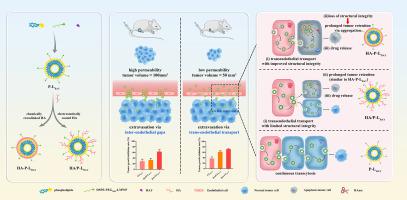当前位置:
X-MOL 学术
›
J. Control. Release
›
论文详情
Our official English website, www.x-mol.net, welcomes your feedback! (Note: you will need to create a separate account there.)
Fine-tuning of liposome integrity for differentiated transcytosis and enhanced antitumor efficacy
Journal of Controlled Release ( IF 10.5 ) Pub Date : 2024-06-14 , DOI: 10.1016/j.jconrel.2024.06.025 Jiajia Su , Chenchen Wu , Jiahui Zou , Xinqiuyue Wang , Kaiyun Yang , Jianping Liu , Zimei Wu , Wenli Zhang
Journal of Controlled Release ( IF 10.5 ) Pub Date : 2024-06-14 , DOI: 10.1016/j.jconrel.2024.06.025 Jiajia Su , Chenchen Wu , Jiahui Zou , Xinqiuyue Wang , Kaiyun Yang , Jianping Liu , Zimei Wu , Wenli Zhang

|
Transcytosis-inducing nanomedicines have been developed to improve tumor extravasation. However, the fate during transcytosis across multicell layers and the structural integrity of the nanomedicines before reaching tumor cells could impact antitumor therapy. Here, a BAY 87–2243 (a hypoxia-inducible factor-1 inhibitor)-loaded liposomal system (HA-P-L) modified by low molecular weight protamine (LMWP) and crosslinked by hyaluronic acid (HA) was constructed. This system could accomplish differentiate cellular transport in endothelial and tumor cells by fine-tuning its structural integrity, i.e. transcytosis across the endothelial cells while preserving structural integrity, facilitating subsequent retention and drug release within tumor cells via degradation-induced aggregation. In vitro cellular uptake and transwell studies demonstrated that HA-P-L were internalized by endothelial cells (bEnd.3) via an active, caveolin and heparin sulfate proteoglycan (HSPG)-mediated endocytosis, and subsequently achieved transcytosis mainly through the ER/Golgi pathway. Moreover, the fluorescence resonance energy transfer (FRET) study showed that HA-crosslinking maintained higher integrity of HA-P-L after transcytosis, more efficiently than electrostatic coating of HA (HA/P-L). In addition, more HA-P-L was retained in tumor cells (4T1) compared to HA/P-L corresponding to its enhanced in vitro cytotoxicity. This may be attributed to better integrity of HA-P-L post endothelial transcytosis and more degradation of HA in tumor cells, leading to more liposome aggregation and inhibition of their transcytosis, which was inferred by both TEM images and the HAase responsiveness assay proved by FRET. In vivo, HA-P-L exhibited more potency in tumor suppression than the other formulations in both low and high permeability tumor models. This highlighted that fine-tuning of structural integrity of nanocarriers played a key role no matter whether the transcytosis of nanocarriers contributed to cellular transport. Collectively, this study provides a promising strategy for antitumor therapies by fine-tuning liposome integrity to achieve active trans-endothelial transport with structural integrity and selective aggregation for prolonged tumor retention.
中文翻译:

微调脂质体完整性以实现差异化转胞吞作用并增强抗肿瘤功效
已开发出诱导转胞吞作用的纳米药物来改善肿瘤外渗。然而,跨多细胞层转胞吞过程的命运以及纳米药物在到达肿瘤细胞之前的结构完整性可能会影响抗肿瘤治疗。在此,构建了由低分子量鱼精蛋白(LMWP)修饰并由透明质酸(HA)交联的 BAY 87-2243(一种缺氧诱导因子 1 抑制剂)负载脂质体系统(HA-P-L)。该系统可以通过微调其结构完整性来实现内皮细胞和肿瘤细胞中的差异化细胞运输,即跨内皮细胞的转胞吞作用,同时保持结构完整性,通过降解诱导的聚集促进随后在肿瘤细胞内的保留和药物释放。体外细胞摄取和跨孔研究表明,HA-P-L 通过活性小窝蛋白和硫酸肝素蛋白聚糖 (HSPG) 介导的内吞作用被内皮细胞 (bEnd.3) 内化,随后主要通过 ER/高尔基体途径实现转胞吞作用。此外,荧光共振能量转移 (FRET) 研究表明,HA 交联在转胞吞作用后保持了 HA-P-L 的更高完整性,比 HA (HA/P-L) 的静电涂层更有效。此外,与HA/P-L相比,更多的HA-P-L保留在肿瘤细胞(4T1)中,这对应于其增强的体外细胞毒性。这可能归因于内皮转胞吞作用后HA-P-L的完整性更好以及肿瘤细胞中HA的更多降解,导致更多的脂质体聚集和对其转胞吞作用的抑制,这是由TEM图像和FRET证明的HAase反应性测定推断的。 在体内,HA-P-L 在低渗透性和高渗透性肿瘤模型中都表现出比其他制剂更强的肿瘤抑制效力。这突出表明,无论纳米载体的转胞吞作用是否有助于细胞运输,纳米载体结构完整性的微调都发挥着关键作用。总的来说,这项研究通过微调脂质体完整性来实现具有结构完整性和选择性聚集的主动跨内皮运输,从而延长肿瘤保留时间,为抗肿瘤治疗提供了一种有前景的策略。
更新日期:2024-06-14
中文翻译:

微调脂质体完整性以实现差异化转胞吞作用并增强抗肿瘤功效
已开发出诱导转胞吞作用的纳米药物来改善肿瘤外渗。然而,跨多细胞层转胞吞过程的命运以及纳米药物在到达肿瘤细胞之前的结构完整性可能会影响抗肿瘤治疗。在此,构建了由低分子量鱼精蛋白(LMWP)修饰并由透明质酸(HA)交联的 BAY 87-2243(一种缺氧诱导因子 1 抑制剂)负载脂质体系统(HA-P-L)。该系统可以通过微调其结构完整性来实现内皮细胞和肿瘤细胞中的差异化细胞运输,即跨内皮细胞的转胞吞作用,同时保持结构完整性,通过降解诱导的聚集促进随后在肿瘤细胞内的保留和药物释放。体外细胞摄取和跨孔研究表明,HA-P-L 通过活性小窝蛋白和硫酸肝素蛋白聚糖 (HSPG) 介导的内吞作用被内皮细胞 (bEnd.3) 内化,随后主要通过 ER/高尔基体途径实现转胞吞作用。此外,荧光共振能量转移 (FRET) 研究表明,HA 交联在转胞吞作用后保持了 HA-P-L 的更高完整性,比 HA (HA/P-L) 的静电涂层更有效。此外,与HA/P-L相比,更多的HA-P-L保留在肿瘤细胞(4T1)中,这对应于其增强的体外细胞毒性。这可能归因于内皮转胞吞作用后HA-P-L的完整性更好以及肿瘤细胞中HA的更多降解,导致更多的脂质体聚集和对其转胞吞作用的抑制,这是由TEM图像和FRET证明的HAase反应性测定推断的。 在体内,HA-P-L 在低渗透性和高渗透性肿瘤模型中都表现出比其他制剂更强的肿瘤抑制效力。这突出表明,无论纳米载体的转胞吞作用是否有助于细胞运输,纳米载体结构完整性的微调都发挥着关键作用。总的来说,这项研究通过微调脂质体完整性来实现具有结构完整性和选择性聚集的主动跨内皮运输,从而延长肿瘤保留时间,为抗肿瘤治疗提供了一种有前景的策略。











































 京公网安备 11010802027423号
京公网安备 11010802027423号